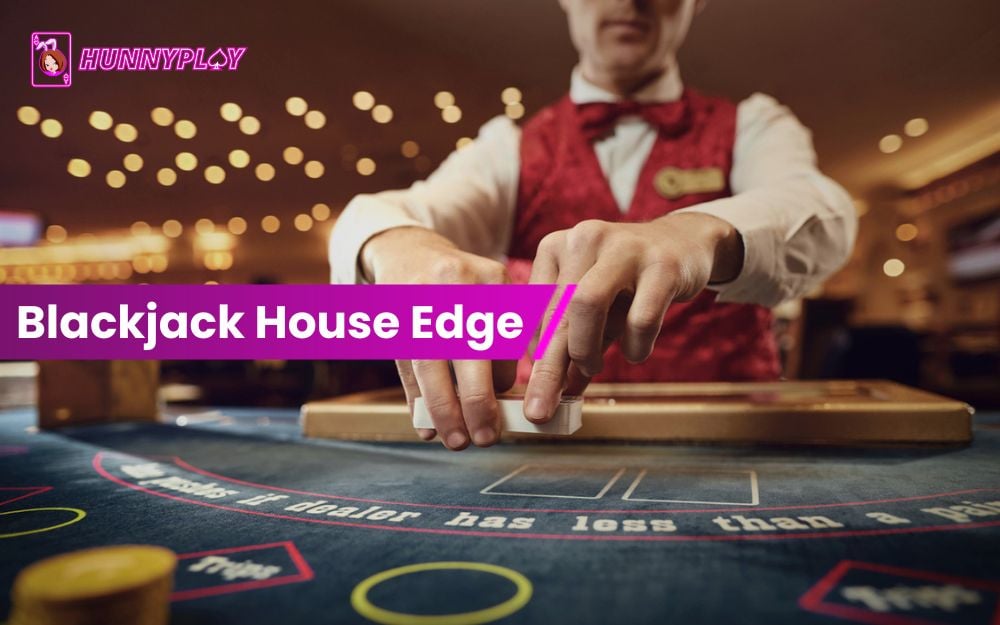Blackjack’s lower House Edge makes it a top-rated game. Understanding this advantage helps players improve their strategy. This HunnyPlay‘s guide covers essential insights on the Blackjack House Edge.
What Is the House Edge in casino game?
Definition House Edge
The House Edge is the percentage that a casino expects to retain from each bet a player places over time.
House Edge vs. Payout rate
The concepts of House Edge and Payout rate are two sides of the same coin.
For example, European roulette has a 2.7% House Edge, meaning its payout rate is 97.3%. Similarly, the popular slot game Starburst offers a payout rate of approximately 96.1%, indicating that the casino retains around 3.9% of all bets.
This built-in advantage guarantees that, regardless of short-term outcomes, the casino will always maintain a financial edge in the long run.
This principle is why casino games are meticulously designed to ensure the house consistently holds an advantage.
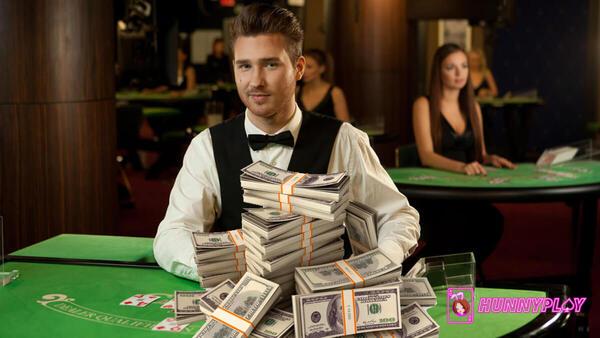
Blackjack House Edge represents the casino’s financial advantage over the long term. (Source: Internet)
Blackjack House Edge: 10 thing you should know
To gain a thorough understanding of the Blackjack House Edge, here are the key insights you need to know. Additionally, you’ll find valuable tips that will enhance your knowledge of the game.
The Blackjack House Edge is more than a number
The Blackjack House Edge varies depending on how you play. If you use perfect strategy, the edge is lower than if you play more casually.
Additionally, the House Edge can differ based on the casino or even the specific version of the game. This variation can range from as low as 0.5% to as high as 4%.
While knowing the House Edge is valuable, it’s not a definitive guide to success.
For instance, if a game has a 5% House Edge, it means you’re expected to lose an average of 5% of your bet each time you wager. So, if you bet $100, you might lose $5 on average per bet.
It seems simple, right? But the math reveals more. If you place 60 bets per hour and lose $5 each time, that’s a loss of $300 per hour.
Conversely, if the House Edge is just 1%, your hourly loss would drop to $60. That’s a significant difference, isn’t it?
It’s crucial to remember that winning or losing involves more than just knowing the House Edge. Sticking with Blackjack alone won’t guarantee success, but understanding these nuances will certainly tilt the odds in your favor—pun intended.
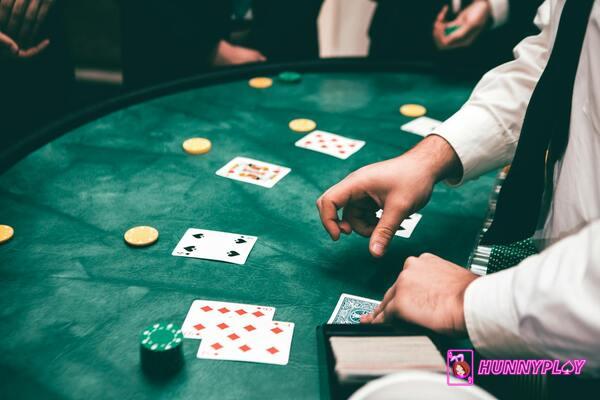
The Blackjack House Edge is lower with perfect strategy than with casual play. (Source: Internet)
The Blackjack House Edge applies over a large number of bets
As with any mathematical calculation, a significant sample size is necessary to draw accurate conclusions.
The House Edge doesn’t hold much weight with a small number of bets. To truly understand the Blackjack House Edge, you need to consider a large sample of wagers.
Let’s break this down with a simple example.
Imagine you’re playing Blackjack with a 1% House Edge and place a $100 bet on a single hand. The outcomes could be:
- $100 Win
- $100 Loss
- $150 Win on a Natural
- A Push
- An Additional $200 Win if You Double Down or Split
Applying mathematical expectations to just one or a few hands doesn’t make sense. Winning or losing a dollar from a single $100 bet isn’t realistic. To see the House Edge in action, you need a significant number of bets.
For example, you might win $100 on one hand or lose $400 over ten hands, resulting in an average loss of $40 per hand. Over one hundred hands, you could have a net loss of $500, averaging $5 per hand.
However, when you reach over 1,000 hands, the outcomes begin to align more closely with mathematical expectations. At 10,000 hands, the results are likely to mirror the expected House Edge.
By the time you’ve played 100,000 hands, your results will almost certainly reflect the House Edge. And at 1 million hands, any deviation from the expected outcome becomes nearly impossible.
Blackjack House Edge is lower than most casino games
When comparing House Edges across various casino games, Blackjack stands out with a significantly lower edge.
This raises an intriguing question: why do casinos continue to offer Blackjack if it’s less profitable than games like Caribbean Hold’em or Casino War?
The answer lies in the profitability of these other games, often referred to as “carnival games” by gambling experts.
Take Casino War, for instance. It has a House Edge of 2.88%. While that might not seem extreme, it’s certainly higher than Blackjack’s edge.
To put this into perspective, if you’re playing Blackjack with a 0.5% House Edge, you’d lose an average of 50 cents for every $100 wagered. In contrast, with Casino War, you’d lose about $2.88 for every $100 bet.
At first glance, this difference might not seem substantial, especially considering you can’t even buy a carnival hotdog for $2.88 these days.
But here’s the catch: most players don’t stop at one hand. They play for an hour or more, which translates to 60 or even 120 hands.
With Blackjack, losing 50 cents per hand could result in a total loss of $3 to $6 after a couple of hours. However, with Casino War, that loss skyrockets to $180 or even $360 in the same time frame.
This illustrates why the Blackjack House Edge, though seemingly small, becomes a critical factor over extended play.
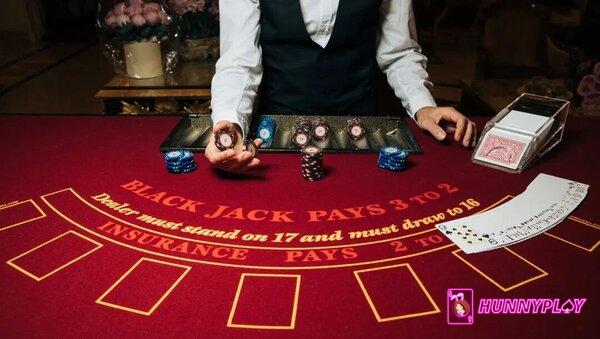
Blackjack stands out with a significantly lower edge. (Source: Internet)
No Blackjack strategy means a higher House Edge
Without using a solid Blackjack strategy, the Blackjack House Edge can quickly rise. Even with basic strategy, the edge might hover around 2%, but it can worsen drastically.
Imagine if you kept hitting until you bust on every hand—this would give the house a 100% edge. While no one plays like this, it highlights how significant the difference in House Edge can be.
Some players mistakenly mimic the dealer’s strategy, thinking it’s a safe approach. This is one of the worst strategies you could adopt in a casino.
Others always assume the dealer has a 10 in the hole, which is closer to basic strategy but still far from foolproof and can lead to costly mistakes.
The bottom line is clear: to keep the Blackjack House Edge as low as possible, you must use perfect Blackjack strategy. Basic strategy helps, but the goal is to reduce the House Edge to its minimum.
Unless you enjoy losing money, using perfect strategy is essential if you’re aiming for success at the Blackjack table.
Calculating your predicted hourly loss in Blackjack
Understanding how to calculate your predicted hourly loss can help you manage your bankroll effectively when playing Blackjack. This involves using the Blackjack House Edge and your betting patterns to estimate your losses over time.
Let’s break it down. To calculate your actual hourly loss, divide your net loss by the number of hours you played. For example, if you played for two hours and lost $200, your loss rate is $100 per hour.
However, to calculate your predicted hourly loss, you use the following formula:
Average bet size * Bets per hour * House Edge = Hourly Expected Loss
Here’s how it works in practice:
Suppose you’re betting $100 per hand at a table where you get 60 hands per hour. If you’re playing with perfect basic strategy and the House Edge is just 0.5%, your expected hourly loss would be:
$100 * 60 * 0.5% = $30/hour
Now, compare this to someone who isn’t using basic strategy, like your friend Steve. If the House Edge against him is 2%, his expected hourly loss would jump to $120/hour.
While these calculations might not perfectly align until you’ve played around 10,000 hands, understanding them is crucial for managing your expectations and gameplay.
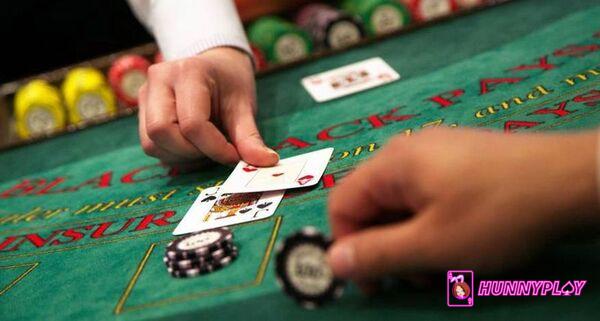
Calculating your predicted hourly loss helps manage your Blackjack bankroll effectively. (Source: Internet)
Counting cards can give you an Edge over the House
Learning to count cards in Blackjack—or mastering other advantage gambling techniques—can tilt the odds in your favor, offering a rare Edge over the House. This isn’t some form of magic; it’s about applying strategic skills beyond basic gameplay.
When you count cards, you track the ratio of high cards to low cards remaining in the deck. When the deck is rich in high cards, like tens and aces, you increase your bets. Here’s why:
- High cards boost your chances of hitting a Blackjack, which pays 3 to 2, increasing the expected value of your bets.
- Conversely, low cards not only reduce the likelihood of getting a Blackjack but also raise your chances of going bust.
- By betting more when the deck is favorable and less when it isn’t, you can shift the odds from the house’s favor to your own.
For instance, using a simple counting system like the Hi-Lo System and adjusting your bets between 1 and 3 units can give you a 1% edge over the house. This advantage allows you to calculate an average expected hourly win rate.
Let’s say you’re betting $100 per hand with a 1% edge; you’re looking at an average win of $60 per hour. However, even with card counting and perfect Blackjack strategy, these results are only likely to manifest over the long term. Don’t expect to consistently be ahead until you’ve played close to 10,000 hands.
It’s also crucial to have a substantial bankroll to withstand statistical deviations, as even skilled card counters can go broke if they aren’t financially prepared for the ups and downs of the game.
The House Edge can vary based on game conditions
The Blackjack House Edge isn’t set in stone; it can fluctuate depending on specific game conditions. Rules can vary widely from one casino to another, or even between tables within the same casino.
For instance, you might be playing a single-deck game, while the table next to you uses eight decks. This difference alone can impact the House Edge significantly.
Other factors that influence the House Edge include whether the dealer hits a soft 17, if you’re allowed to double down after splitting, and how much you get paid for a natural Blackjack (a two-card hand totaling 21).
The next few points will explore how these common rule variations can affect the House Edge. So, stay tuned for more insights!
More decks of cards mean a higher Blackjack House Edge
The Blackjack House Edge increases when more decks of cards are used, a rule variation that might seem counterintuitive at first. Why would the House Edge rise simply because more decks are in play?
While the initial ratio of high to low cards remains the same regardless of the number of decks, the key difference lies in the probability of getting a Blackjack.
Consider a single-deck game: if your first card is an ace, there are 51 cards left in the deck, 16 of which have a value of 10. This gives you a 31.37% chance of getting a Blackjack, which pays out at 3 to 2.
Now, compare this with an eight-deck game. After being dealt an ace, there are 415 cards left, 128 of which are worth 10. This lowers your probability of getting a Blackjack to 30.84%.
Although the difference may seem minor—just 0.25%—it adds up over time, making a significant impact on the House Edge in the long run. Fewer Blackjacks ultimately mean a higher House Edge, which is why more decks favor the casino.
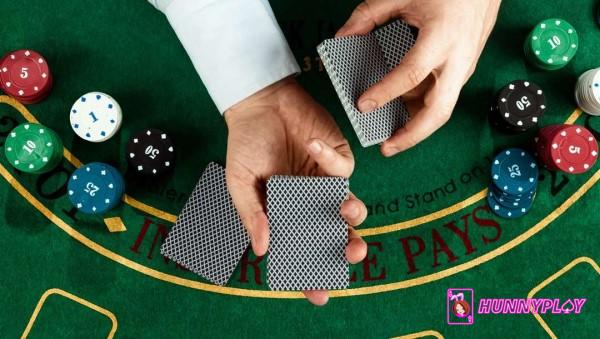
Fewer Blackjacks increase the House Edge, making multiple decks favor the casino. (Source: Internet)
A dealer hitting a Soft 17 can impact the Blackjack House Edge
Indeed, whether a dealer hits or stands on a soft 17 can significantly influence the Blackjack House Edge.
Typically, everyone knows that the dealer must hit on a total of 16 or less, and it’s always satisfying to see the dealer bust. However, the rules vary when it comes to a soft 17—a hand that includes an ace, which can be counted as 11 or 1.
In some casinos, the dealer must stand on a soft 17, while in others, the dealer is required to hit. This difference is clearly indicated on the table, with signs stating either:
- Dealer must stand on all 17s
- Dealer hits soft 17
At first glance, you might think that a dealer hitting a soft 17 would increase the chances of them busting, which is true. However, when the dealer doesn’t bust, their hand often improves significantly.
This happens frequently enough that it actually increases the House Edge by about 0.2% in games where the dealer hits a soft 17, making it less favorable for the player.
Improve Blackjack House Edge by doubling after a Split
Doubling down after a split can positively affect the House Edge in Blackjack, making it more favorable for the player.
Most players understand that doubling down is advantageous because it allows you to increase your bet when the odds are in your favor.
Doubling down after splitting enhances this benefit by giving you even more opportunities to capitalize on favorable hands. While not every hand will be a winner, focusing your bets on those with better odds can lead to greater profits.
However, not all casinos allow this option. If you’re playing at a table where doubling after a split is permitted, you can reduce the House Edge by about 0.15%.
If you ever encounter a live dealer Blackjack game that doesn’t allow doubling after a split, you might wonder if the game is unfair.
But these rules vary depending on the casino, and they might seem illogical to a novice player. Rest assured, though—this variation doesn’t mean the game is rigged.
Conclusion
In summarize, understanding the Blackjack House Edge is crucial for improving your gameplay. Mastering these aspects can give you an advantage in both traditional and online casinos. For an exceptional Blackjack experience, visit HunnyPlay and play smarter.




















